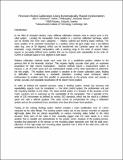Precision Robot Calibration Using Kinematically Placed Inclinometers
| dc.contributor.author | Robertson, Alec P. | |
| dc.contributor.author | Slocum, Alexander | |
| dc.contributor.author | Willoughby, Patrick J. | |
| dc.date.accessioned | 2002-09-17T15:34:47Z | |
| dc.date.available | 2002-09-17T15:34:47Z | |
| dc.date.issued | 2002-09-17T15:34:47Z | |
| dc.identifier.uri | http://hdl.handle.net/1721.1/1669 | |
| dc.description.abstract | In the field of industrial robotics, many different calibration methods exist to reduce error in the robot system. Locating the manipulator home position is a common calibration technique, which can be divided into three main categories — relative, optimal and leveling based methods. The home position of an industrial manipulator is a position where all joint angles have a pre-defined value (e.g. zero or 90 degrees), which can be transformed into Cartesian space via the robot kinematics. Large industrial manipulators, with a working range in the order of several meters, require an accurately defined home position that can be restored with repeatability in the order of 0.2mm in Cartesian space or 0.01 degrees in Joint space. | en |
| dc.format.extent | 147280 bytes | |
| dc.format.mimetype | application/pdf | |
| dc.language.iso | en_US | |
| dc.subject | robot calibration | en |
| dc.subject | kinematic coupling | en |
| dc.subject | inclinometer | en |
| dc.subject | leveling devices | en |
| dc.title | Precision Robot Calibration Using Kinematically Placed Inclinometers | en |
Files in this item
This item appears in the following Collection(s)
-
Ford-MIT Alliance
Institute-wide collaboration focusing on statistical engineering, virtual education, and the environment
